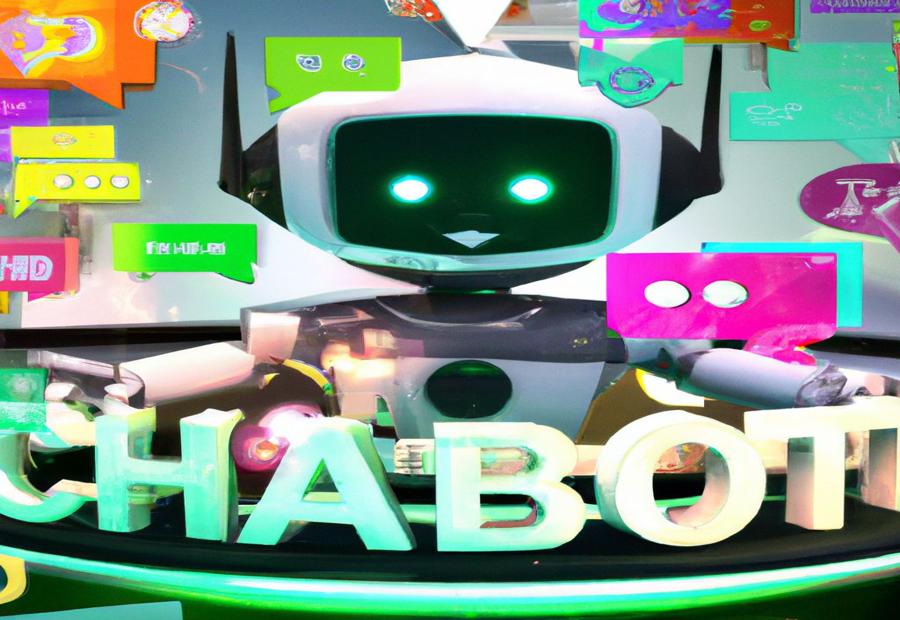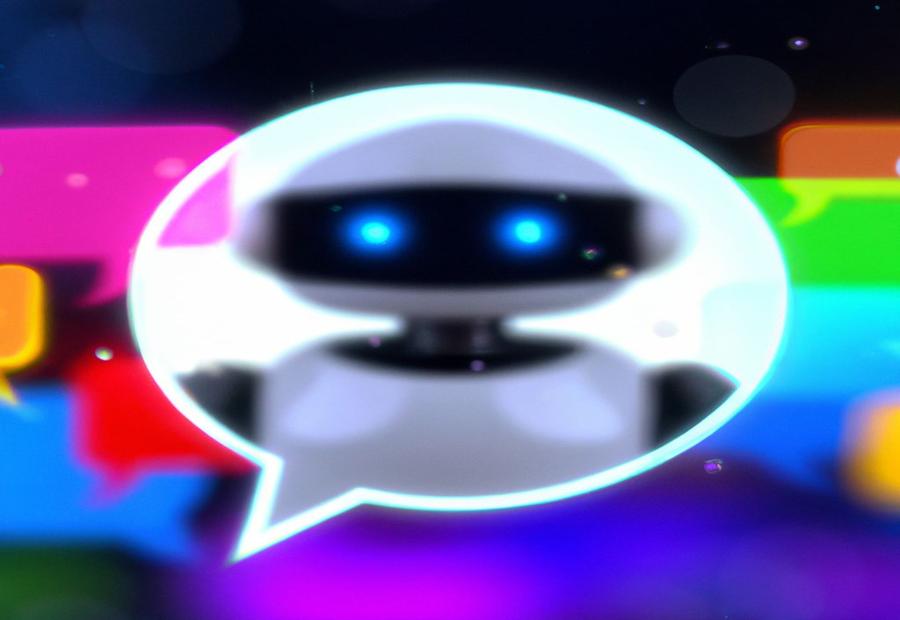Best Practices for Training AI Chatbots
Key Takeaway:
- Properly trained chatbots provide numerous benefits, including improved customer satisfaction, increased efficiency, and cost savings.
- Poorly trained chatbots can have negative consequences, such as frustrating user experiences, damage to brand reputation, and loss of customer trust.
- Key terminology in chatbot training includes utterances (user inputs), intents (the purpose or goal behind a user’s input), and entities (specific pieces of information within an utterance).
When it comes to training AI chatbots, there are significant benefits to ensure they are properly trained. From improved customer satisfaction to increased efficiency, proper training lays the foundation for a successful chatbot implementation. On the other hand, the consequences of poorly trained chatbots can range from frustrated users to damaged brand reputation. In this section, we’ll dive into the importance of training chatbots effectively and the potential pitfalls of neglecting this crucial step.
Benefits of Properly Trained Chatbots
Properly trained chatbots have great benefits. They can answer customer queries quickly and provide automated assistance, to reduce workload on customer service teams. They can even chat with multiple people at the same time. With conversation data analysis, chatbots give businesses valuable insights. This leads to improved customer satisfaction, loyalty, and convenience. Plus, chatbots reduce human error in responding to inquiries. Investment in properly trained chatbots brings improved efficiency, user experience, and customer satisfaction.
However, poorly trained chatbots can cause a PR nightmare and therapist appointments!
Consequences of Poorly Trained Chatbots
Chatbots not properly trained? No good! Consequences can be dire. Miscommunication, inaccurate info, and a damaged reputation.
Miscommunication with users? Poorly trained chatbots struggle to understand user inquiries. Resulting in a negative experience, and potential loss of customers.
Inaccurate information? Chatbots without the right training may give incorrect or incomplete info. Misinformation or important details overlooked. Bad user experience, and business operations impacted.
Reputation? If chatbots fail to meet user expectations, or make mistakes, it can damage the brand’s reputation. Loss of trust and credibility with customers.
Businesses must invest in proper training for chatbots. To avoid miscommunications, provide accurate info, and maintain a positive brand image.
Are you in the know? Utterances, intents, entities – the chatbot training dictionary you never knew you needed.
Key Terminology in Chatbot Training
Key Terminology in Chatbot Training: Gain insight into the fundamental elements of chatbot training such as utterances, intents, and entities. Discover how these components play a crucial role in training AI chatbots to understand and respond effectively to user inputs. Uncover the significance of each term and how they contribute to the development and refinement of chatbot capabilities.
Utterances
Utterances are essential for chatbot training. They capture the multiple ways users communicate with the bots. This data helps chatbots to understand and answer user interactions accurately.
Utterances are conversations recorded by users to interact with chatbots. They record the language patterns and nuances used in real conversations. Analyzing these utterances allows chatbots to recognize patterns, identify intents and extract entities to give relevant answers.
See the table below to understand the importance of utterances in training:
| Column 1 | Column 2 | Column 3 |
|---|---|---|
| Input | Intent | Entity Extraction |
| User Query 1 | Purchase | Product Name: [Laptop] |
| User Query 2 | FAQ | Category: [Shipping] |
| User Query 3 | Complaint | Concern: [Delivery] |
Diverse utterances help chatbots become familiar with different language styles, dialects and speech patterns. This lets them handle a wide range of queries with ease. Incorporating such inputs into the training process makes chatbots more adaptable and responsive, which improves the user experience.
Creating unique intents is essential for chatbot training, as we don’t want our bots to have multiple personalities.
Intents
Intents are key to chatbot functionality. They’re like guides, outlining how the chatbot should handle different questions and problems. By categorizing intents, the chatbot can understand and respond to requests. Creating intents is important for the bot to manage a variety of queries. To do this, it needs to learn various utterances related to each intent. This training is necessary for the chatbot to comprehend and answer user queries accurately.
Understanding intents is key for an efficient chatbot. It gives organizations the chance to improve their customer service, speed up information retrieval processes, and provide a better user experience. With analysis of conversation data, intents can be optimized to get the most out of AI-driven chatbots.
Chatbots can bring huge benefits to businesses, like customer satisfaction and increased operational efficiency. An article called “Best Practices for Training AI Chatbots” discusses the importance of training chatbots to do this.
Entities also play an important role in chatbot functionality. They act as detectives, helping the chatbot understand specific information in user inputs. Entities make it easier for the chatbot to understand and respond to queries.
Entities
Entities are key for chatbot training. Utterances are user messages with intents and entities. Intents are user goals and entities are details. Know the use cases, identify intents, make diverse utterances. Involve team members from different departments. Add brand-aligned personality and media elements. Keep improving and analyzing conversation data. Find the right balance with AI capabilities and decision tree-based approaches. That’s essential chatbot training!
Defining Use Cases and Problems to Solve
When it comes to training AI chatbots effectively, one crucial aspect is defining use cases and pinpointing the problems they aim to solve. In this section, we will explore the importance of identifying specific purposes for the chatbot, developing distinct intents for each purpose, and creating diverse utterances that reflect real-world language use. By understanding these key elements, we can lay a solid foundation for building chatbots that deliver accurate and relevant responses to users’ queries.
Identifying Specific Purposes for the Chatbot
Chatbot purposes are essential for effective training. Organizations can create chatbots that meet the individual needs of their users by recognizing particular purposes. This approach ensures the chatbot can manage special queries and offer valuable help.
- Grasping users’ needs: To find out the specific purposes of a chatbot, one must comprehend the special needs and issues of users.
- Fulfilling organizational objectives: Organizations have to determine how the chatbot can assist in reaching their overall goals, such as improving customer service or increasing sales.
- Supplying relevant information: The chatbot should give accurate and up-to-date data that is tailored to each user’s particular needs.
- Serving different user personas: A well-trained chatbot should be able to recognize and adapt to different types of users, like new customers, existing customers, or potential leads.
- Improving efficiency in tasks: Knowing the purposes of a chatbot involves understanding how it can streamline processes and automate repetitive tasks, saving time for both users and employees.
- Increasing customer satisfaction: By understanding the exact purposes a chatbot serves, organizations can guarantee users have a positive experience interacting with the bot, leading to higher customer satisfaction rates.
To make the process of finding out specific purposes for a chatbot even more effective, organizations should carry out thorough market research. This will enable them to understand industry trends and customer expectations better. Plus, they should use user feedback and analytics data from past interactions with the chatbot to constantly refine its purpose and performance.
Don’t miss out on maximizing your chatbot’s potential by failing to identify its particular purposes. By understanding what your users need and customizing your chatbot’s features accordingly, you can provide a superior user experience, increase efficiency, and improve customer satisfaction. Begin figuring out the purposes of your chatbot today to stay ahead of the competition and make the most out of this valuable technology.
Developing Distinct Intents for Each Purpose
Developing intents for each purpose is key. Ensure all queries related to a use case are covered. This approach helps avoid gaps and provides an effective response. Involve members from different departments to bring diverse perspectives and expertise.
Enhance the chatbot training by adding personality traits aligned with the brand identity. This creates an engaging interaction experience. Utilize media elements such as images or videos to add visual or auditory cues.
Continuous improvement and analysis are vital when refining chatbot training. Regular updates allow for adapting to changing user needs. Leverage conversation data insights like user preferences and common queries for valuable information. Understand AI in chatbot training and select the right technology to achieve an optimal balance between AI capabilities and decision tree-based approaches.
Creating Diverse Utterances for Real-World Language Use
For chatbots to understand and answer users’ queries in real-world scenarios, diverse utterances need to be created during training. Diversifying examples during training will help chatbots comprehend natural language and accurately interpret user inputs.
- Analyze language use: Examine different dialects, slang, and formal/informal variations.
- Generate various utterances: Use data from real interactions or create new examples covering a range of scenarios.
- Cover common and uncommon use cases: Include both commonly encountered and more unusual utterances.
- Consider context and user intents: Align each example with one or more distinct intents the chatbot is designed to recognize and respond to.
- Regularly update training data: Adapt according to new language patterns and usage trends.
- Analyze conversation data for improvements: Identify areas for improvement and guide the creation of diverse utterances for training.
Diverse utterances are essential for chatbots to understand and answer users’ queries. Consider different types of language, generate various utterances, cover common and uncommon use cases, and update training data regularly. Analyzing conversation data helps in improving the user experience.
Building a Diverse Training Team
Building a diverse training team for AI chatbots is crucial for success. By involving members from various departments, we can ensure comprehensive coverage of potential queries. Studies show that diverse teams bring fresh perspectives and enhance problem-solving capabilities. Collaboration among individuals with different backgrounds and expertise fosters innovation. With a diverse training team, we can tap into a rich pool of knowledge and experiences, leading to a well-rounded and effective AI chatbot.
Involving Members from Various Departments
Involving members from various departments is key for successful chatbot training. By including individuals from customer service, IT, and marketing, a mixed training team can cover all potential queries and perspectives. This ensures the chatbot is well-rounded and ready to take on any user interactions.
Involving members from different departments helps to bring a complete approach to problem-solving and decision making. Each department has unique insights and expertise that can help create intents for each purpose of the chatbot. Organizations can use this expertise to make an efficient chatbot that meets users’ needs.
Involving various departments also fosters collaboration and cross-functional learning. Team members can work together to understand different parts of the organization’s operations. This joint approach promotes understanding and better communication between the team.
By involving members from various departments in chatbot training, organizations can use multiple perspectives, knowledge and skills to create an intelligent conversational agent that offers improved user experiences across multiple domains. So, your chatbot won’t run from a tough question like a scared puppy!
Ensuring Comprehensive Coverage of Potential Queries
It’s essential to have comprehensive coverage of potential queries for effective chatbot training. To do this, create a diverse team from different departments. Include use cases and scenarios in the training process. Gather insights from conversation data to improve the chatbot’s performance. For extra personality, add media elements like emojis and GIFs! This way, you can ensure the chatbot can handle a wide array of user inquiries.
Incorporating Personality and Media Elements

Photo Credits: Artificialintelligencechatbot.Ai by Arthur Jackson
Incorporating personality and media elements can take your AI chatbot to the next level. Discover how adding personality for brand alignment and engagement, as well as using media elements to enhance user experience, can transform the way users interact with your chatbot. With research-backed strategies and proven techniques, you can create a chatbot that not only meets users’ needs but also leaves a lasting impression. Get ready to revolutionize your AI chatbot experience!
Adding Personality for Brand Alignment and Engagement
Adding character to a chatbot is very important. It helps build an original identity that shows the values and tone of the brand. This makes interactions more personal and likeable, leading to greater user pleasure and loyalty to the brand. Incorporate elements like language style, humor and tone into the chatbot’s responses.
- Having personality makes the chatbot talk in a way that appeals to the target audience, forming a stronger link between users and the brand.
- This also reinforces continuity and strengthens brand recognition.
- The chatbot can adapt its tone based on the context of the conversation, making it seem more natural and human-like.
- A well-defined personality attracts attention, encourages engagement, and makes the brand stand out from its competitors.
- Adding elements like emojis and GIFs creates a visually appealing and memorable experience.
It is necessary to guarantee that the personality is in line with the overall tone across all channels. This ensures users have the same experience with a human or chatbot.
Pro Tip: When adding personality to a chatbot, look at user feedback and conversation data to spot areas that need improvement. This ongoing process ensures continuous development of the chatbot’s character for the best results.
Using Media Elements to Enhance User Experience
Adding media elements is a powerful way to elevate the user experience when training chatbots. By including images, videos, and audio clips, chatbots can involve users in an interactive way and provide an immersive experience. This has several advantages, such as drawing in user attention and interest, plus increasing their satisfaction with the chatbot conversation.
One great advantage of using visually attractive media elements, such as images and videos, is that it makes the chatbot conversation more exciting and pleasurable for users. It helps them to comprehend information better, particularly when handling complicated concepts or product demonstrations.
Moreover, media elements can help to explain the context and purpose of responses by providing visual or sound cues. This increases user understanding, reducing confusion and improving communication.
Also, by using media elements that create emotions, chatbots can build a stronger connection with users. For example, using emotive images or videos can produce empathy or excitement, making the conversation more engaging.
In conclusion, media elements create a higher user satisfaction by making interactions more dynamic and memorable. Users are more likely to be pleased with a chatbot that provides visually rich content, as it gives a feeling of personalized engagement.
However, it is essential to remember that inserting media elements should be done strategically and in line with the brand personality and goal of the chatbot. The media should support the conversation flow, instead of distracting or overwhelming users.
By consistently adapting and assessing, the key to chatbot training success is never settling for average. By using media elements to improve the user experience, chatbots can successfully involve and satisfy users, creating a more significant and meaningful interaction.
Continuous Improvement and Analysis

Photo Credits: Artificialintelligencechatbot.Ai by Brian Mitchell
Continuous improvement and analysis play a vital role in optimizing AI chatbot performance. Through regular updates and learning opportunities, chatbots can evolve and enhance their capabilities. Additionally, gathering insights from conversation data enables businesses to understand customer needs better and refine the chatbot experience. Embracing these practices ensures that AI chatbots consistently deliver accurate, relevant, and efficient responses, ultimately improving customer satisfaction and driving business success.
Regular Updates and Learning Opportunities
Regular updates and learning are vital for bot training. This includes regularly maintaining, fixing bugs, adding new features and enhancing the bot.
Plus, bots should continuously learn from user interactions. This involves analyzing conversations to identify areas of improvement and get insights for better performance.
Continuous improvement is key. Updating and learning helps the bot stay accurate, understanding and responsive. This results in better user experiences.
Track metrics and feedback to assess the effectiveness of updates and learning. This allows for further optimization and keeps the bot aligned with user needs.
Regular updates and learning opportunities help businesses streamline their operations and increase customer satisfaction.
Gathering conversation data is the key to understanding users and refining the bot’s skills.
Gathering Insights from Conversation Data
Gathering insights from conversation data is vital for chatbot training. Analyzing chats between the bot and users gives great info to improve performance. Patterns, areas for improvement, and user needs and preferences are examined.
Organizations can collect and analyze this data to figure out common issues or concerns raised by users. This can lead to better customer satisfaction and problem resolution.
Incorporating conversational data analysis into the chatbot training process lets companies tailor their responses. This means meeting user expectations and addressing inquiries better.
Gathering insights from conversation data keeps organizations updated on user preferences, trends, and potential areas for improvement. This feedback helps with continuous learning and improving chatbot capabilities. It also shows any gaps in the knowledge base or training materials, allowing for quick updates or modifications.
In conclusion, gathering insights from conversation data is key for optimizing chatbot performance. It offers an understanding of user needs, proactive issue resolution, and ongoing improvements for an exceptional user experience. This valuable resource helps organizations stay ahead in the rapidly evolving field of AI-powered chatbots.
Understanding the Role of AI in Chatbot Training
Understanding the role of AI in chatbot training is crucial for optimizing their performance. This section explores how to choose the right chatbot technology and strike a balance between AI capabilities and a decision tree-based approach. By delving into the fundamentals, we can effectively harness the power of AI to develop robust and intelligent chatbots.
Choosing the Right Chatbot Technology
When it comes to AI chatbot success, technology plays a key role. To ensure optimal performance, efficiency and user satisfaction, the right tech must be chosen. It’s vital to consider the various options and functionalities available.
Comparing chatbot technologies is easy with a table. Businesses can pick the best option based on their needs. Here are the main factors to consider:
| Factor | Description |
|---|---|
| NLU Capability | Does the tech have advanced NLU abilities? This ensures effective user-bot communication and a great user experience. |
| Integration | How easy is it to integrate the tech with existing systems like CRM, CMS or ERP? |
| Customization | Does the chatbot tech allow customization for business needs? This boosts performance and user engagement. |
| Scalability | Can the tech handle increased workloads as the business grows? A scalable solution keeps the bot responsive. |
Alongside these factors, research the vendor’s reputation, track record and customer support services. Do your homework and get advice to make the right choice.
The right chatbot technology has been a game changer for customer service. Companies have seen improvements in customer satisfaction, efficiency and cost savings. Chatbot tech is growing in relevance and demand for efficient, intelligent conversational AI is increasing.
Balance between AI Capabilities and Decision Tree-based Approach
Training an AI chatbot is like teaching a kid with a dark sense of humor. It’s all fun and games until someone gets offended. To achieve a successful chatbot, striking the right balance between AI capabilities and a decision tree-based approach is key.
AI brings dynamic, intelligent responses and allows understanding and responding to user inputs. It can analyze natural language, infer meaning and generate contextually relevant responses.
A decision tree-based approach offers structure. It maps out possible user inputs and provides pre-determined responses based on specific conditions. It can ensure consistency in the chatbot’s behavior, but may limit its ability to adapt.
When creating a chatbot, consider factors such as the desired level of customization, the complexity of user queries expected and the need for scalability. Combining AI capabilities with a decision tree-based approach can bring an effective chatbot.
For example, an e-commerce company’s customer support chatbot could be intelligent and reliable. AI capabilities allow it to understand natural language queries and provide personalized recommendations. The decision tree-based approach ensures common issues like order tracking or returns are handled efficiently.
Conclusion

Photo Credits: Artificialintelligencechatbot.Ai by Randy Harris
Effective chatbot training is crucial for achieving optimal performance. In this conclusion, we will emphasize the significance of prioritizing chatbot training and highlight the importance of implementing best practices. Furthermore, we will provide a concise summary of the key takeaways and highlight the essential aspects of chatbot training that organizations should focus on. So, let’s dive into the final section and wrap up our exploration of the best practices for training AI chatbots.
Emphasizing the Need for Effective Chatbot Training
Investing in chatbot training is essential. Without it, the chatbot can’t understand user queries, leading to bad experiences.
Organizations should focus on training their chatbots to get the desired benefits. It helps them understand natural language, and respond appropriately.
Personality traits can be included too, to enhance customer engagement and loyalty.
Continuous improvement is needed too. With regular updates and data analysis, areas for optimization can be identified and performance improved.
Finding the right AI technology is important too. Striking a balance between AI capabilities and decision tree-based approaches helps optimize chatbot performance.
Summary of Best Practices
Best Practices for Training AI Chatbots:
- Utterances, intents, and entities are key in chatbot training. Defining specific purposes and having distinct intents for each ensures good performance.
- Building a diverse team of people from many departments will provide comprehensive coverage of potential queries.
- Adding personality and media elements creates brand alignment and user engagement.
- Regular updates, learning, and analyzing conversation data is vital for successful training.
- Choosing the right chatbot tech is important too. It should balance AI capabilities with a decision tree-based approach. This will achieve optimal performance and keep control over responses.
In summary, effective chatbot training needs consideration of utterances, intents, entities, use cases, and a diverse team, plus personality and media elements. Constant improvement through analyzing conversation data is essential to improve performance and ensure success.
To understand the role of AI in chatbot development, it’s crucial to follow best practices and refine the chatbot’s training approach. Doing this will help create an AI chatbot that’s user-friendly and provides valuable support.
Some Facts About Best Practices for Training AI Chatbots:
- ✅ Chatbots should be trained by a diverse team from various departments to cover all potential queries and provide a better user experience. (Source: hubtype.com)
- ✅ Defining specific use cases and creating distinct intents are crucial steps in training AI chatbots effectively. (Source: techtarget.com)
- ✅ Adding personality to chatbots and using media elements like videos and images can enhance user engagement. (Source: boost.ai)
- ✅ Continuous monitoring and improvement are necessary for a successful AI chatbot, as customer requirements evolve over time. (Source: chatbot.com)
- ✅ Training AI chatbots involves understanding key phrases, such as intents, utterances, and entities, to accurately interpret user needs and provide relevant responses. (Source: revechat.com)
FAQs about Best Practices For Training Ai Chatbots
What are the golden rules for training AI chatbots?
According to the guide on chatbot best practices, some golden rules for training AI chatbots include identifying the business’s problems that the chatbot will solve, choosing the right chatbot technology, involving a diverse training team, defining target customers, continuously monitoring and improving the chatbot’s interactions, and planning user flow and conversation flows.
How can I create a compelling chatbot story?
Creating a compelling chatbot story can be challenging. One way to create a compelling chatbot story is to look at existing examples for inspiration. It is also important to consider the tone of voice and personality that matches your brand image. Additionally, integrating interactive components like videos and product suggestions can enhance the user’s experience and engagement.
What are some effective strategies for lead generation with chatbots?
Using chatbots for lead generation can be beneficial for businesses. One strategy is to automate inquiries related to lead generation. By automating lead generation, businesses can improve customer satisfaction and gather valuable information. Additionally, using trigger messages and calendar workflows can increase the number of product demos and effectively engage with potential leads.
How can chatbots help with booking appointments?
Chatbots can be useful for streamlining the appointment booking process. By implementing a chatbot, businesses can offer quick support answers and simplify the appointment scheduling process. Customers can interact with the chatbot to check availability, book appointments, and track their status. This not only saves time for both customers and businesses, but also helps in organizing and managing appointments more efficiently.
How can AI chatbots effectively engage with customers?
To effectively engage with customers, AI chatbots should be designed to provide information in a conversational and interactive manner. Using conversational interfaces, such as button-based menus or voice commands, can enhance the user experience. Additionally, incorporating interactive components like videos, images, and emojis can further engage customers and make the chatbot more user-friendly.
What are some tips for ensuring a successful channel integration for chatbots?
For successful channel integration, businesses should consider the preferred medium of communication for their target audience. Whether it is through a website, mobile app, or messaging channels like Facebook Messenger, the chatbot should be seamlessly integrated into the chosen channel. This allows businesses to provide unified support across multiple platforms and effectively interact with customers in their preferred channel of communication.
AI Chatbot Team







